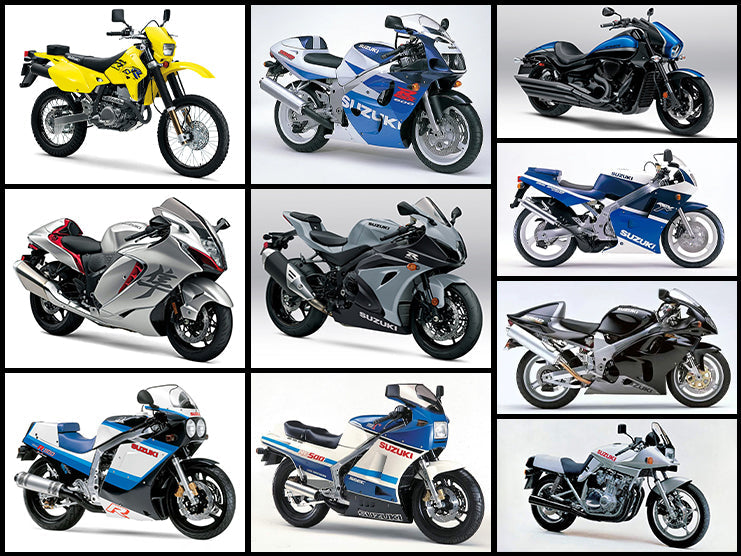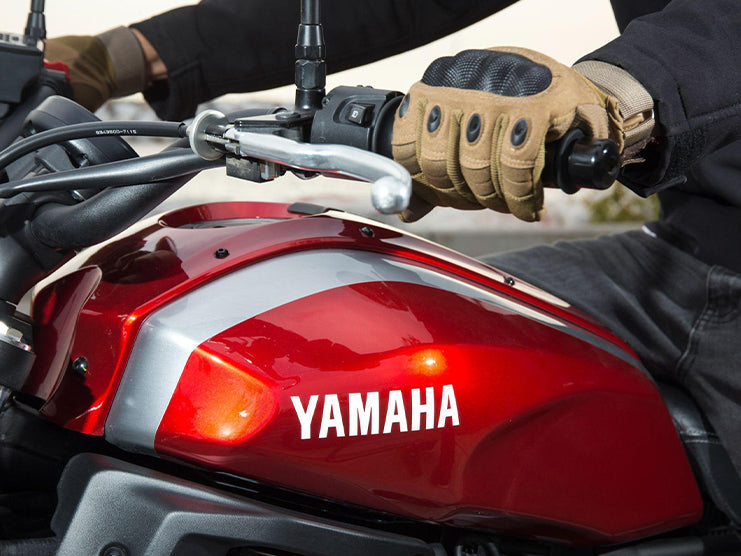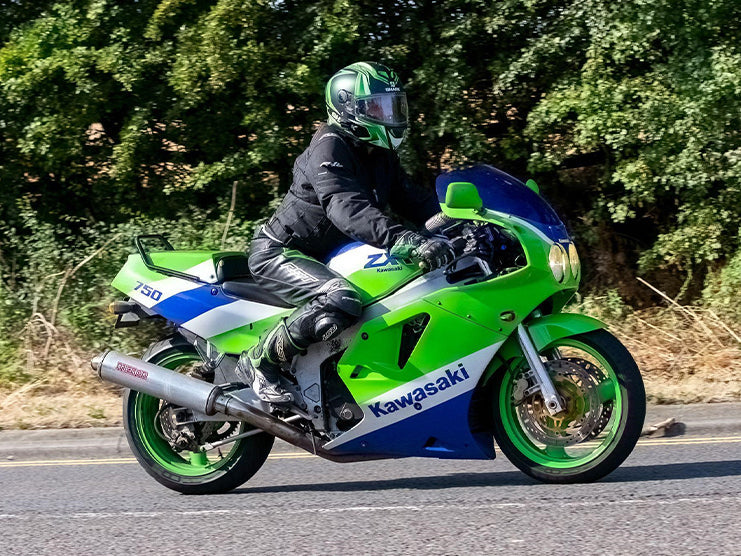Long before Suzuki came into the motorcycle business, the company was famous for manufacturing looms. These precision machines were used to make fabric. Today, Suzuki utilizes the same degree of precision in its motorcycles.
Suzuki reinvented itself to enter the motorcycle business. The company’s aim was to change the face of racing with its iconic race and sports bike. But Suzuki did not restrict itself to the production of sports bikes only; instead, it produced great bikes for different motorcycle segments, including dual-sport, adventure, touring bikes, street bikes, and cruisers. This article has compiled a list of the ten best motorcycles Suzuki ever made.
Table of Content
Michio Suzuki founded the Suzuki Loom company in 1909. Michio invented a unique weaving machine. The company prospered even in post-World War II Japan. For over five decades, Suzuki dominated the global loom market. In 1951, Suzuki company faced the greatest financial challenge due to the global cotton market collapse. In 1952, Michio Suzuki reinvented himself and the company by selecting another machine for manufacturing. Hence, Michio Suzuki decided to create a machine, using the same technology and precision of his looms, that would help the people in the post-World War II era.
1. Inventing the Suzuki Power Free
People at that time needed cheap but reliable transportation. Michio Suzuki applied his technical genius to invent a motorized bicycle. He named the newly invented bike, Power Free. Power Free had a 36 cc engine and produced only 1 hp of horsepower. Power Free was the first moped motorcycle ever made.
Suzuki Power Free had a typical bicycle frame with a tiny Suzuki original engine.
The moped had a unique gear system that allowed riders to pedal the motorcycle and let the engine support the movement, or stop pedaling and ride solely on the engine power. Impressed by the revolutionary vehicle, Power Free, the Japanese government provided funds to Michio Suzuki to research motorcycle engineering. In 1953, Suzuki designed a new Power Free that featured a 60 cc engine and produced 2 hp of horsepower. During its first production year, the Power Free won Japan’s most prestigious road race, the Mount Fuji Hill Climb competition. Winning the race further changed Suzuki’s identity. It was not only a company that created a practical and cheap mode of transportation but an establishment that reinvented racing.
1.1 Suzuki Colita - The True Motorcycle
In 1954, Suzuki created its first true motorcycle, the Suzuki Colita. By this time, Suzuki was manufacturing 6,000 motorcycles each month and had officially changed its company name to Suzuki Motors Co., Ltd. In 1956, the company overhauled Colita and equipped it with a two-cylinder engine. In 1959, Suzuki was all set to test its motorcycles against Japan’s biggest motorcycle companies. Entering Colita in the 1959 Mount Asama Volcano race was the only way Suzuki could prove its engineering prowess, and the brand did just that. Unfortunately, three of the five Suzuki Colita motorcycles broke down in the race and only one bike made it to the finish line. But for one lap, Suzuki motorcycles dominated the race track, outperforming all other bikes. The Colita recorded the fastest lap of five minutes and 50 seconds. Though Suzuki didn’t win, this small achievement set the company’s direction. Suzuki had to create fast motorcycles that could cover long stretches of road.
1.2 Suzuki RM62- Winner of 1962 Isle of Man TT Race
In the 1960s, Suzuki was set to enter the most important motorcycle race in the world, the Isle of Man Race. This race was part of the Grand Prix motorcycle racing season. To win this race, Suzuki hired Ernst Degner, a professional Grand Prix motorcycle racer hailing from Germany. Degner helped Suzuki get exposure to the bikes used in the West. In 1962, Degner rode the Suzuki RM62, 125 cc motorcycle, and won the Isle of Man TT. Winning this race helped Suzuki increase brand awareness not just in Japan but also in the United States and Europe. The growing demand of motorcycles further helped Suzuki reinvent its new motorcycle based on the global motorcycle market trends.
1.3 Suzuki T20 - The Fastest 250 cc Bike of Its Time
In 1965, Suzuki designed and built the T20 motorcycle aimed at the US motorcycle market. The T20 featured a 250 cc and had a top speed of 90 mph. Hence, considered one of the fastest motorcycles of its time. In addition, the Suzuki T20 was the world’s first motorcycle with a six-speed transmission.
The Suzuki T20 was a good race bike and a practical street bike with its two-stroke engine, but it was also a bit too loud and created a lot of smoke. But for Suzuki, T20 was a milestone achievement.
1.4 Suzuki T500 - The Largest Motorcycle 2-Cycle Engine
By 1968, Suzuki launched the T500 with the largest two-cylinder engine, having a displacement of 500 cc. This new motorcycle could reach the top speed of 110 mph. This stylish vintage model was known for its unprecedented power and perrformance.
After launching the Suzuki T500, the company developed a global reputation for being one of the most reliable motorcycle manufacturer and supplier. The well-developed low-maintenance components were installed in the bikes that further augmented the brand’s sales and success within Japan and in foreing markets, including the United States.
1.5 Suzuki GS 750 - Exploring the Super Bike Market
After the success of the Suzuki T500, the comapny decided to explore the superbike market and acquire a significant share in this motorcycle segment. This decision was crucial for the brand if it wanted to compete with the other Japanese brands, such as Honda, Yamaha, and Kawasaki, who were focused on manufacturing high-end, performance-oriented sports bikes in the 1970s and 1980s. Resultantly, Suzuki engineers and designers came came up with its iconic GS lineup that would help the brand reinvent itself. The GS 750 was the company’s first motorcycle with a four-stroke design.
The bike was quieter and cleaner. The Suzuki GS 750 generated an impressive horsepower of 72 hp and also boasted a top speed of 130 mph; hence, it was the ultimate bike for a speed junkie. With the GS750 model, Suzuki got a chance to successfully produce and market the four-stroke engine, which was a milestone achievement for the brand. However, the brand chose not to stagnate its success and decided to take on a new challenge; which entailed completely transforming the global motorcycle scenery.
1.6 Suzuki GSXR 750 - The Top-Notch Race Model
As a result of Suzuki’s new mission to change the shape of the global motorcycle market, the company manufactured a new racing bike, the GSXR 750. While the GS lineup already comprised sporty motorcycles, the GSXR 750 model was designed specifically for race track enthusiasts. Briefly put, these bikes were swift, sturdy, and smooth. Though the GS 750 was a popular motorcycle, the GSXR 750 replaced it almost overnight. With its GSXR 750, Suzuki set new standards for the modern sport bike segment. Featuring powerful brakes, full fairings, lightweight aluminum frames, and advanced suspension systems, the GSXR 750 was a fun bike to ride. The motorcycle entered the 1985 Le Mans Endurance Race and was a huge success on the race track. In 1989, after a four-year hiatus, Suzuki won the Daytona 100 race by entering its auspicious race bike, GSXR 750. These victories made Suzuki a major player in the global motorcycle market.
2. The Best of Suzuki’s Motorcycle Craftsmanship
From a 36 cc moped to a 750 cc superbike, Suzuki has had quite an inspirational journey. The motorcycle company managed to crack the highly competitive industry and emerge as a corporate giant in a span of 13 years. Its success was cemented after winning the 1962 Isle of Man TT race. But the launch of its GS series with a four stroke engine design took Suzuki’s success to new heights.
After the GS 750, Suzuki produced many great bikes. The high-performers of Suzuki are listed below:
2.1 The Suzuki GSXR-1000

Launched in 2001, Suzuki GSX-R1000 has played a key role in the evolution of sports bikes. The bike succeeded the GSX-R11000 and took the sport bike designing and engineering one step forward. The first model featured a 988 inline four stroke engine and aluminum frame. The 2005 model featured an improved aerodynamic front and advanced technological features. In 2007, the bike’s engine capacity was increased. In addition, throttle response and chassis were improved for a nimble and effortless riding experience. The 20009 onward models came with riding modes, upgraded suspension system, and traction control. In 2017, The Suzuki GSX-R1000 was improved to meet the Euro 4 emission standards. The GSXR1000 has a remarkable racing heritage that makes it a racing icon even today.
2.2 The Suzuki TL1000R

Suzuki TL1000R was designed to compete with Honda and Ducati V–Twin engine technology. TL1000R was introduced in 1998 and competed in races organized by the American Motorcycle Association (AMA) and World SuperBike Championship. The motorcycle only won a single race, but developed a huge fan following for its distinct styling. TL1000’s Lack of performance in the important racing events compelled Suzuki to discontinue the bike in 2003 in favor of GSX-R750. Some of the TL1000R’s notable features include a 996 cc V-Twin, advanced rear suspension, and fuel injection system.
2.3 The Suzuki GSX 1300 R Hayabusa

The Suzuki GSX 1300 R Hayabusa was launched in 1999 and it took the motorcycle world by storm with its extraordinary speed and impressive handling. Powered by a 1299 cc engine, the Hayabusa could reach a top speed of over 180 mph. Suzuki discontinued Hayabusa after the 2020 model year to meet the emission standards. A third generation Hayabusa was introduced in 2021 with an improved engine design, exhaust, and tech features much to the delight of Hayabusa fans.
2.4 The Suzuki GSX-S1100S Katana

Suzuki designed the GSX-S1100S Katana to let the motorcycle world know what a stylistic two-wheeler looks like. Launched in the 1980s when motorcycles of different brands looked almost the same, GSX-S1100S Katana was the most stylish motorcycle of its time. The bike was discontinued after 2006 and relaunched after 2019. The newer models pay homage to the original Katana launched in 1981. In addition, the bike features a 1000 cc engine that can generate 150 hp of horsepower, Brembo brake calipers, inverted forks, GSX-R swingarm, and an alloy frame.
2.5 The Suzuki RGV250

Suzuki RGV250 is a two-stroke race bike powered by a 250 cc engine. According to Suzuki engineers, the RGV250 was born on race tracks. True to their claim, the bike outperformed all other bikes of its time on the race track and is still faster than many modern sport bikes. The RGV250 ruled the race tracks and the street throughout the 1980s and 1990s. Other than the bike’s powerful liquid cooled engine, its nimble chassis made it perfect for everyday use and race tracks. Today the Suzuki RGV250 is considered an icon of Suzuki’s racing heritage and has become a sought-after collectible.
2.6 The Suzuki RG500 Gamma

Suzuki RG500 Gamma is another popular motorcycle from Suzuki’s racing heritage segment. The bike was introduced in the 1980s and became popular because of its unique square four two-stroke engine design. The liquid-cooled engine displaced 498 cc and offered an impressive weight-to-power ratio. The RG500 Gamma was one of the most celebrated high-achievers in the Grand Prix 500 cc category. Such was the popularity of this bike that Suzuki had to create a street-legal version of its bike after the racing variant. Today the RG500 Gamma is considered a vintage motorcycle.
2.7 The Suzuki GSX-R1100

Suzuki GSX-R1100 was introduced in the mid 1980s and was powered by an inline four engine. Though the motorcycle was nimble, stylish, and fast, it failed to serve its purpose, to outperform Honda’s FireBlade. Luckily, the bike was not complete and managed to secure decent sales due to its sporty character, weight to power ratio, and race bike aesthetics. In drag racing and endurance racing, GSXR-1100 emerged as a bike of choice for many private riders who enjoyed modifying the motorcycle according to their riding styles. Though the GSX-R1100 was not a huge success, the motorcycle is important because it revived the sportbike segment and popularized fully-faired motorcycles.
2.8 The Suzuki GSX-R 600 SRAD

The Suzuki GSX-R600 SRAD was launched in the 1990s and featured a unique Ram Air Direct engine. These engines are designed in such a way that when the rider increases the speed, the flow of air into the engine increases as well. Hence, the overall engine power is then increased. However, Suzuki is not the only one who designed and utilized Ram Air Direct engines to produce powerful motorcycles. Kawasaki had already introduced similar engines in their sports bikes in 1990. It may be possible that Suzuki sought inspiration from Kawasaki for its GSX-R600 model as the latter had already launched motorcycles based on the ram-air direct technology in the early 1900s. As expected, the Suzuki GSX-R600 SRAD garnered much praise for its simple engineering, high power outputs, and exciting styling cues. The bike proved to be an instant success among riders of varied skill levels, especially race bike rides.
2.9 The Suzuki Boulevard M109R B.O.S.S

As Suzuki gained global recognition, it stepped into different motorcycle segments, including street bikes, race bikes, and sports bikes. In each segment, Suzuki managed to manufacture atleast one model that helped it acquire a significant market share. While Suzuki’s motorcycles were also well-accepted in the United States, the company decided to create power-cruisers for Americans who were looking for affordable yet performance-oriented cruisers. Competing with a brand like Harley Davidson was a huge challenge for Suzuki. Yet it succeeded in acquiring considerable market share through its cruiser lineups. The Suzuki Boulevard M109R was one of the most successful cruiserr lineups by the brand. Launched in 2006, this motorcycle was powered by a big-bore V-twin 1783 cc motor that could produce 125 hp of horsepower and 160 Nm of torque.
The power outputs combined with the bike’s customizability allowed riders to use for long-distance touring. The reliable engineering guaranteed low failure rate essential for a comfortable riding experience. Due to the remarkable success of Suzuki Booulevard M109 R B.O.S.S, it is still under production. The 2023 model is equipped with functional luggage bags, distinct headlight cowling, drag-style handlebars, and an engine guard set.
2.10 Suzuki DR-Z400 S

The Suzuki DR-Z400S is a dual sport motorcycle that adventure seekers can ride on urban streets and a variety of off-road terrain. The DR-Z400S was developed in the late 90s and introduced in 2001. Ever since its launch, the bike did not undergone any significant changes and is still in its original form after more than two decades. The bike is powered by a 398 cc liquid-cooled DOHC single-cylinder engine that produces manageable power, allowing inexperienced riders to explore the adventure segment of the motorcycles. Though the DR-Z400 S is carbureted with a simple dashboard, it is still the de facto choice of adventure bike riders due to its purposeful nature. The bike offers adequate mileage of 44-50 mpg, allowing riders to cover long distances without frequent breaks. Due to the increased demand of the motorcycle, Suzuki has announced the 2024 model of the DR-Z400 S on its official website.
3. Last Words
Suzuki has been delivering technological excellence to the world through its high-performing motorcycles for about seven decades. The company started out as a loom manufacturer but transformed into a motorcycle manufacturer due to a financial setback. Some riders might argue that Suzuki’s current motorcycles are not the best in the world; however, one cannot deny that Suzuki has made some major contributions to shaping the modern motorcycle landscape. The list compiled in this article celebrates Suzuki’s milestone achievements in the form of powerful motorcycles.













Leave a comment
All comments are moderated before being published.
This site is protected by hCaptcha and the hCaptcha Privacy Policy and Terms of Service apply.